Tutorial Questions Analysis: HI6028 Taxation Theory, Practice and Law
VerifiedAdded on 2023/01/11
|8
|1911
|87
Homework Assignment
AI Summary
This document presents a comprehensive analysis of tutorial questions focused on Australian taxation. The assignment delves into key aspects of the Australian tax system, including the functions of taxation, the role of the Australian Taxation Office (ATO), and residency tests. It examines income tax principles, deductions, and the implications of misleading advertising. Furthermore, the assignment explores the concept of leases and the deductibility of related expenses. A significant portion of the document is dedicated to depreciation methods, comparing the prime cost method and the diminishing value method, and their impact on tax deductions. The solutions provided are designed to help students understand and apply taxation principles to real-life scenarios, offering valuable insights into tax law and practice.

Tutorial questions
Paraphrase This Document
Need a fresh take? Get an instant paraphrase of this document with our AI Paraphraser

TABLE OF CONTENTS
Week 1.......................................................................................................................................3
Week 2.......................................................................................................................................3
Week 3.......................................................................................................................................4
Week 4.......................................................................................................................................5
Week 5.......................................................................................................................................6
REFERENCES...........................................................................................................................8
Week 1.......................................................................................................................................3
Week 2.......................................................................................................................................3
Week 3.......................................................................................................................................4
Week 4.......................................................................................................................................5
Week 5.......................................................................................................................................6
REFERENCES...........................................................................................................................8
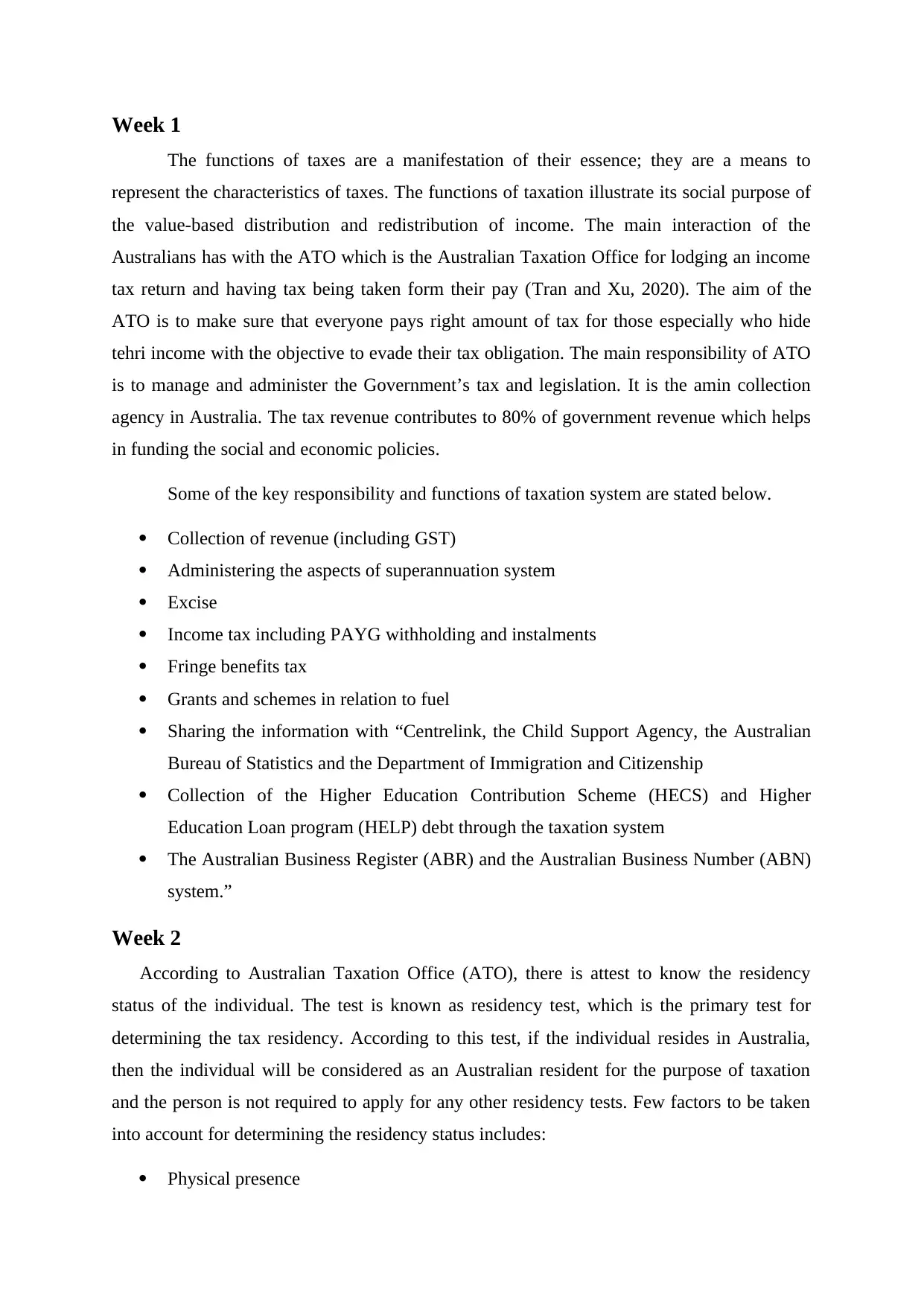
Week 1
The functions of taxes are a manifestation of their essence; they are a means to
represent the characteristics of taxes. The functions of taxation illustrate its social purpose of
the value-based distribution and redistribution of income. The main interaction of the
Australians has with the ATO which is the Australian Taxation Office for lodging an income
tax return and having tax being taken form their pay (Tran and Xu, 2020). The aim of the
ATO is to make sure that everyone pays right amount of tax for those especially who hide
tehri income with the objective to evade their tax obligation. The main responsibility of ATO
is to manage and administer the Government’s tax and legislation. It is the amin collection
agency in Australia. The tax revenue contributes to 80% of government revenue which helps
in funding the social and economic policies.
Some of the key responsibility and functions of taxation system are stated below.
Collection of revenue (including GST)
Administering the aspects of superannuation system
Excise
Income tax including PAYG withholding and instalments
Fringe benefits tax
Grants and schemes in relation to fuel
Sharing the information with “Centrelink, the Child Support Agency, the Australian
Bureau of Statistics and the Department of Immigration and Citizenship
Collection of the Higher Education Contribution Scheme (HECS) and Higher
Education Loan program (HELP) debt through the taxation system
The Australian Business Register (ABR) and the Australian Business Number (ABN)
system.”
Week 2
According to Australian Taxation Office (ATO), there is attest to know the residency
status of the individual. The test is known as residency test, which is the primary test for
determining the tax residency. According to this test, if the individual resides in Australia,
then the individual will be considered as an Australian resident for the purpose of taxation
and the person is not required to apply for any other residency tests. Few factors to be taken
into account for determining the residency status includes:
Physical presence
The functions of taxes are a manifestation of their essence; they are a means to
represent the characteristics of taxes. The functions of taxation illustrate its social purpose of
the value-based distribution and redistribution of income. The main interaction of the
Australians has with the ATO which is the Australian Taxation Office for lodging an income
tax return and having tax being taken form their pay (Tran and Xu, 2020). The aim of the
ATO is to make sure that everyone pays right amount of tax for those especially who hide
tehri income with the objective to evade their tax obligation. The main responsibility of ATO
is to manage and administer the Government’s tax and legislation. It is the amin collection
agency in Australia. The tax revenue contributes to 80% of government revenue which helps
in funding the social and economic policies.
Some of the key responsibility and functions of taxation system are stated below.
Collection of revenue (including GST)
Administering the aspects of superannuation system
Excise
Income tax including PAYG withholding and instalments
Fringe benefits tax
Grants and schemes in relation to fuel
Sharing the information with “Centrelink, the Child Support Agency, the Australian
Bureau of Statistics and the Department of Immigration and Citizenship
Collection of the Higher Education Contribution Scheme (HECS) and Higher
Education Loan program (HELP) debt through the taxation system
The Australian Business Register (ABR) and the Australian Business Number (ABN)
system.”
Week 2
According to Australian Taxation Office (ATO), there is attest to know the residency
status of the individual. The test is known as residency test, which is the primary test for
determining the tax residency. According to this test, if the individual resides in Australia,
then the individual will be considered as an Australian resident for the purpose of taxation
and the person is not required to apply for any other residency tests. Few factors to be taken
into account for determining the residency status includes:
Physical presence
⊘ This is a preview!⊘
Do you want full access?
Subscribe today to unlock all pages.

Trusted by 1+ million students worldwide
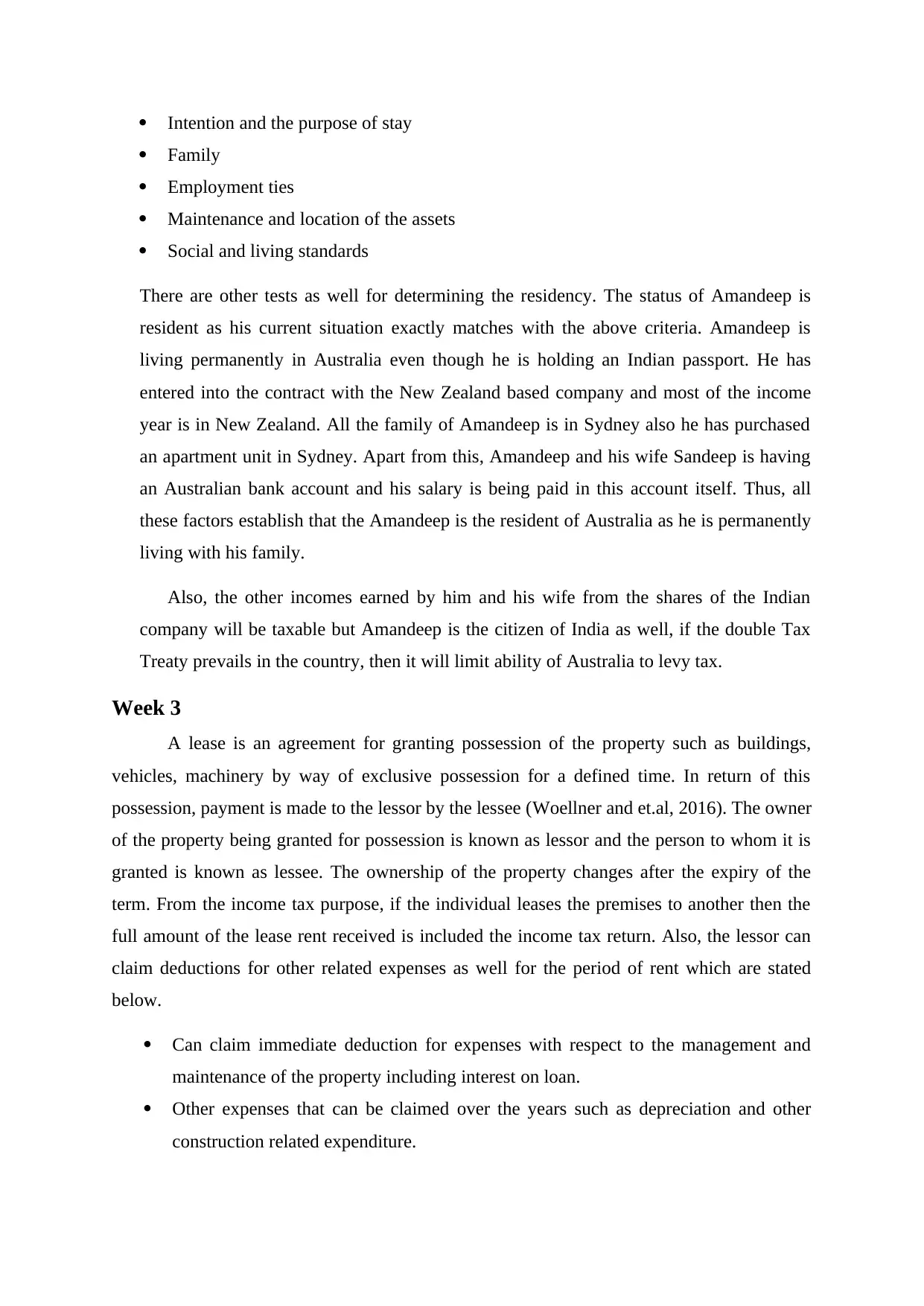
Intention and the purpose of stay
Family
Employment ties
Maintenance and location of the assets
Social and living standards
There are other tests as well for determining the residency. The status of Amandeep is
resident as his current situation exactly matches with the above criteria. Amandeep is
living permanently in Australia even though he is holding an Indian passport. He has
entered into the contract with the New Zealand based company and most of the income
year is in New Zealand. All the family of Amandeep is in Sydney also he has purchased
an apartment unit in Sydney. Apart from this, Amandeep and his wife Sandeep is having
an Australian bank account and his salary is being paid in this account itself. Thus, all
these factors establish that the Amandeep is the resident of Australia as he is permanently
living with his family.
Also, the other incomes earned by him and his wife from the shares of the Indian
company will be taxable but Amandeep is the citizen of India as well, if the double Tax
Treaty prevails in the country, then it will limit ability of Australia to levy tax.
Week 3
A lease is an agreement for granting possession of the property such as buildings,
vehicles, machinery by way of exclusive possession for a defined time. In return of this
possession, payment is made to the lessor by the lessee (Woellner and et.al, 2016). The owner
of the property being granted for possession is known as lessor and the person to whom it is
granted is known as lessee. The ownership of the property changes after the expiry of the
term. From the income tax purpose, if the individual leases the premises to another then the
full amount of the lease rent received is included the income tax return. Also, the lessor can
claim deductions for other related expenses as well for the period of rent which are stated
below.
Can claim immediate deduction for expenses with respect to the management and
maintenance of the property including interest on loan.
Other expenses that can be claimed over the years such as depreciation and other
construction related expenditure.
Family
Employment ties
Maintenance and location of the assets
Social and living standards
There are other tests as well for determining the residency. The status of Amandeep is
resident as his current situation exactly matches with the above criteria. Amandeep is
living permanently in Australia even though he is holding an Indian passport. He has
entered into the contract with the New Zealand based company and most of the income
year is in New Zealand. All the family of Amandeep is in Sydney also he has purchased
an apartment unit in Sydney. Apart from this, Amandeep and his wife Sandeep is having
an Australian bank account and his salary is being paid in this account itself. Thus, all
these factors establish that the Amandeep is the resident of Australia as he is permanently
living with his family.
Also, the other incomes earned by him and his wife from the shares of the Indian
company will be taxable but Amandeep is the citizen of India as well, if the double Tax
Treaty prevails in the country, then it will limit ability of Australia to levy tax.
Week 3
A lease is an agreement for granting possession of the property such as buildings,
vehicles, machinery by way of exclusive possession for a defined time. In return of this
possession, payment is made to the lessor by the lessee (Woellner and et.al, 2016). The owner
of the property being granted for possession is known as lessor and the person to whom it is
granted is known as lessee. The ownership of the property changes after the expiry of the
term. From the income tax purpose, if the individual leases the premises to another then the
full amount of the lease rent received is included the income tax return. Also, the lessor can
claim deductions for other related expenses as well for the period of rent which are stated
below.
Can claim immediate deduction for expenses with respect to the management and
maintenance of the property including interest on loan.
Other expenses that can be claimed over the years such as depreciation and other
construction related expenditure.
Paraphrase This Document
Need a fresh take? Get an instant paraphrase of this document with our AI Paraphraser
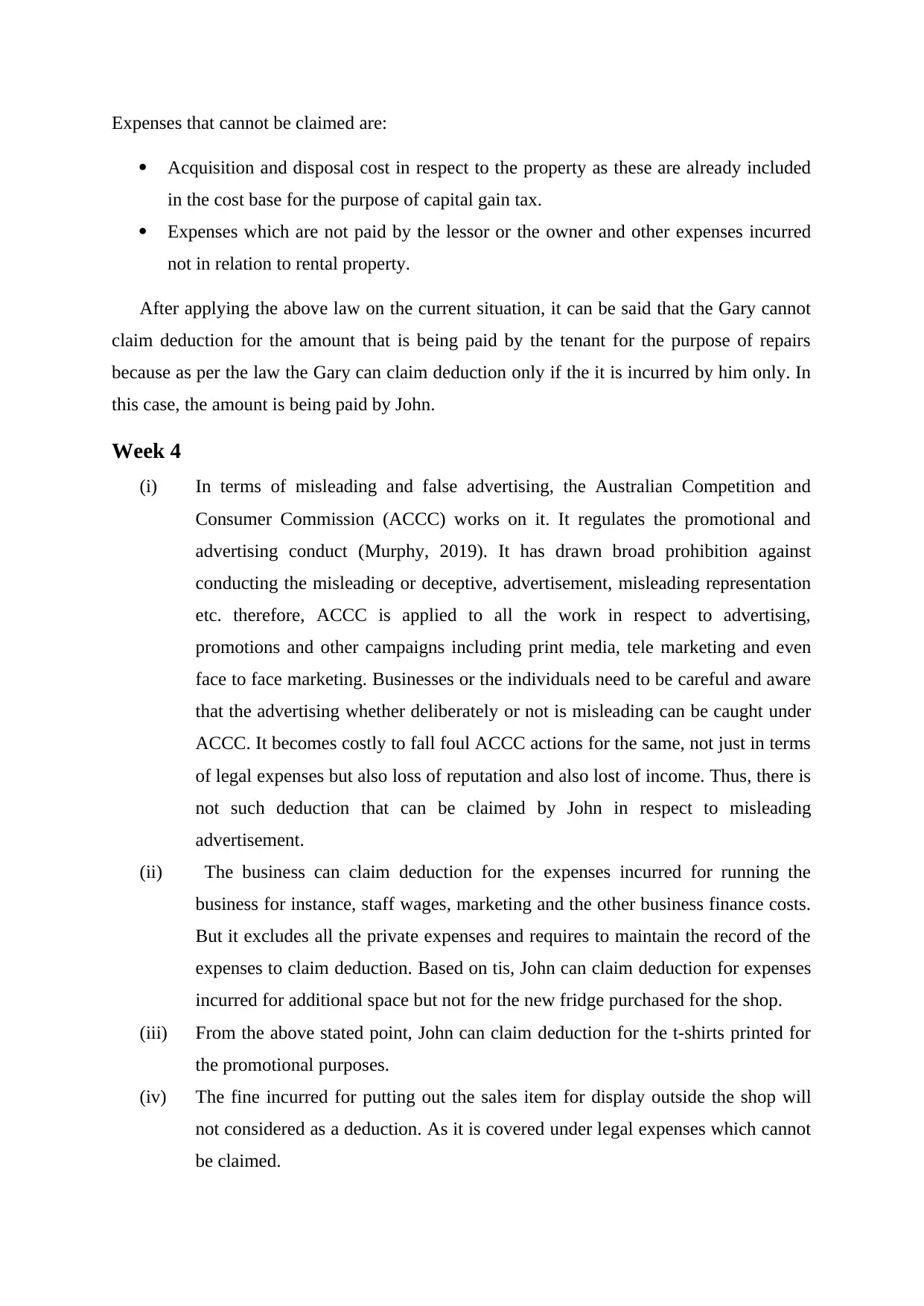
Expenses that cannot be claimed are:
Acquisition and disposal cost in respect to the property as these are already included
in the cost base for the purpose of capital gain tax.
Expenses which are not paid by the lessor or the owner and other expenses incurred
not in relation to rental property.
After applying the above law on the current situation, it can be said that the Gary cannot
claim deduction for the amount that is being paid by the tenant for the purpose of repairs
because as per the law the Gary can claim deduction only if the it is incurred by him only. In
this case, the amount is being paid by John.
Week 4
(i) In terms of misleading and false advertising, the Australian Competition and
Consumer Commission (ACCC) works on it. It regulates the promotional and
advertising conduct (Murphy, 2019). It has drawn broad prohibition against
conducting the misleading or deceptive, advertisement, misleading representation
etc. therefore, ACCC is applied to all the work in respect to advertising,
promotions and other campaigns including print media, tele marketing and even
face to face marketing. Businesses or the individuals need to be careful and aware
that the advertising whether deliberately or not is misleading can be caught under
ACCC. It becomes costly to fall foul ACCC actions for the same, not just in terms
of legal expenses but also loss of reputation and also lost of income. Thus, there is
not such deduction that can be claimed by John in respect to misleading
advertisement.
(ii) The business can claim deduction for the expenses incurred for running the
business for instance, staff wages, marketing and the other business finance costs.
But it excludes all the private expenses and requires to maintain the record of the
expenses to claim deduction. Based on tis, John can claim deduction for expenses
incurred for additional space but not for the new fridge purchased for the shop.
(iii) From the above stated point, John can claim deduction for the t-shirts printed for
the promotional purposes.
(iv) The fine incurred for putting out the sales item for display outside the shop will
not considered as a deduction. As it is covered under legal expenses which cannot
be claimed.
Acquisition and disposal cost in respect to the property as these are already included
in the cost base for the purpose of capital gain tax.
Expenses which are not paid by the lessor or the owner and other expenses incurred
not in relation to rental property.
After applying the above law on the current situation, it can be said that the Gary cannot
claim deduction for the amount that is being paid by the tenant for the purpose of repairs
because as per the law the Gary can claim deduction only if the it is incurred by him only. In
this case, the amount is being paid by John.
Week 4
(i) In terms of misleading and false advertising, the Australian Competition and
Consumer Commission (ACCC) works on it. It regulates the promotional and
advertising conduct (Murphy, 2019). It has drawn broad prohibition against
conducting the misleading or deceptive, advertisement, misleading representation
etc. therefore, ACCC is applied to all the work in respect to advertising,
promotions and other campaigns including print media, tele marketing and even
face to face marketing. Businesses or the individuals need to be careful and aware
that the advertising whether deliberately or not is misleading can be caught under
ACCC. It becomes costly to fall foul ACCC actions for the same, not just in terms
of legal expenses but also loss of reputation and also lost of income. Thus, there is
not such deduction that can be claimed by John in respect to misleading
advertisement.
(ii) The business can claim deduction for the expenses incurred for running the
business for instance, staff wages, marketing and the other business finance costs.
But it excludes all the private expenses and requires to maintain the record of the
expenses to claim deduction. Based on tis, John can claim deduction for expenses
incurred for additional space but not for the new fridge purchased for the shop.
(iii) From the above stated point, John can claim deduction for the t-shirts printed for
the promotional purposes.
(iv) The fine incurred for putting out the sales item for display outside the shop will
not considered as a deduction. As it is covered under legal expenses which cannot
be claimed.
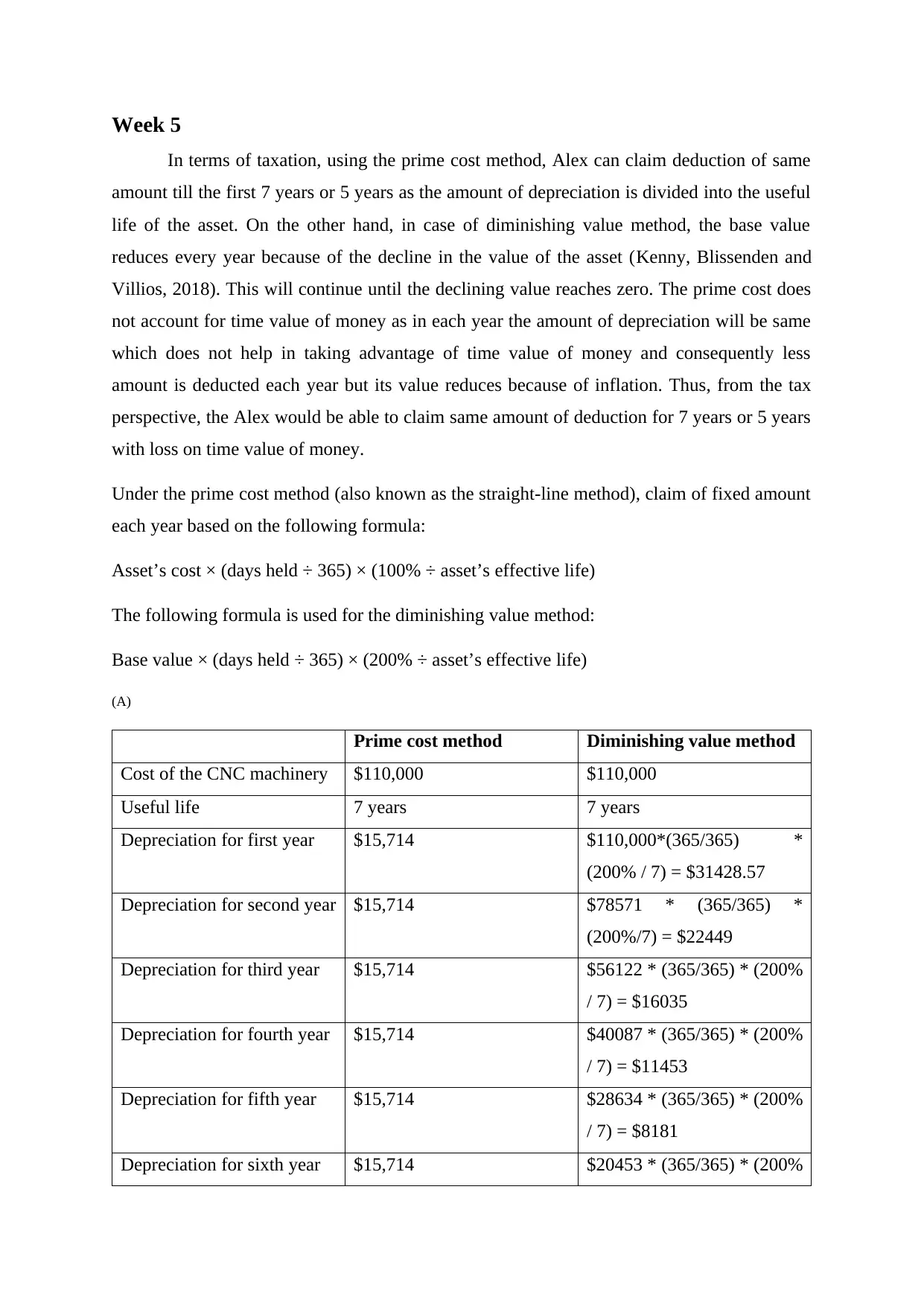
Week 5
In terms of taxation, using the prime cost method, Alex can claim deduction of same
amount till the first 7 years or 5 years as the amount of depreciation is divided into the useful
life of the asset. On the other hand, in case of diminishing value method, the base value
reduces every year because of the decline in the value of the asset (Kenny, Blissenden and
Villios, 2018). This will continue until the declining value reaches zero. The prime cost does
not account for time value of money as in each year the amount of depreciation will be same
which does not help in taking advantage of time value of money and consequently less
amount is deducted each year but its value reduces because of inflation. Thus, from the tax
perspective, the Alex would be able to claim same amount of deduction for 7 years or 5 years
with loss on time value of money.
Under the prime cost method (also known as the straight-line method), claim of fixed amount
each year based on the following formula:
Asset’s cost × (days held ÷ 365) × (100% ÷ asset’s effective life)
The following formula is used for the diminishing value method:
Base value × (days held ÷ 365) × (200% ÷ asset’s effective life)
(A)
Prime cost method Diminishing value method
Cost of the CNC machinery $110,000 $110,000
Useful life 7 years 7 years
Depreciation for first year $15,714 $110,000*(365/365) *
(200% / 7) = $31428.57
Depreciation for second year $15,714 $78571 * (365/365) *
(200%/7) = $22449
Depreciation for third year $15,714 $56122 * (365/365) * (200%
/ 7) = $16035
Depreciation for fourth year $15,714 $40087 * (365/365) * (200%
/ 7) = $11453
Depreciation for fifth year $15,714 $28634 * (365/365) * (200%
/ 7) = $8181
Depreciation for sixth year $15,714 $20453 * (365/365) * (200%
In terms of taxation, using the prime cost method, Alex can claim deduction of same
amount till the first 7 years or 5 years as the amount of depreciation is divided into the useful
life of the asset. On the other hand, in case of diminishing value method, the base value
reduces every year because of the decline in the value of the asset (Kenny, Blissenden and
Villios, 2018). This will continue until the declining value reaches zero. The prime cost does
not account for time value of money as in each year the amount of depreciation will be same
which does not help in taking advantage of time value of money and consequently less
amount is deducted each year but its value reduces because of inflation. Thus, from the tax
perspective, the Alex would be able to claim same amount of deduction for 7 years or 5 years
with loss on time value of money.
Under the prime cost method (also known as the straight-line method), claim of fixed amount
each year based on the following formula:
Asset’s cost × (days held ÷ 365) × (100% ÷ asset’s effective life)
The following formula is used for the diminishing value method:
Base value × (days held ÷ 365) × (200% ÷ asset’s effective life)
(A)
Prime cost method Diminishing value method
Cost of the CNC machinery $110,000 $110,000
Useful life 7 years 7 years
Depreciation for first year $15,714 $110,000*(365/365) *
(200% / 7) = $31428.57
Depreciation for second year $15,714 $78571 * (365/365) *
(200%/7) = $22449
Depreciation for third year $15,714 $56122 * (365/365) * (200%
/ 7) = $16035
Depreciation for fourth year $15,714 $40087 * (365/365) * (200%
/ 7) = $11453
Depreciation for fifth year $15,714 $28634 * (365/365) * (200%
/ 7) = $8181
Depreciation for sixth year $15,714 $20453 * (365/365) * (200%
⊘ This is a preview!⊘
Do you want full access?
Subscribe today to unlock all pages.

Trusted by 1+ million students worldwide
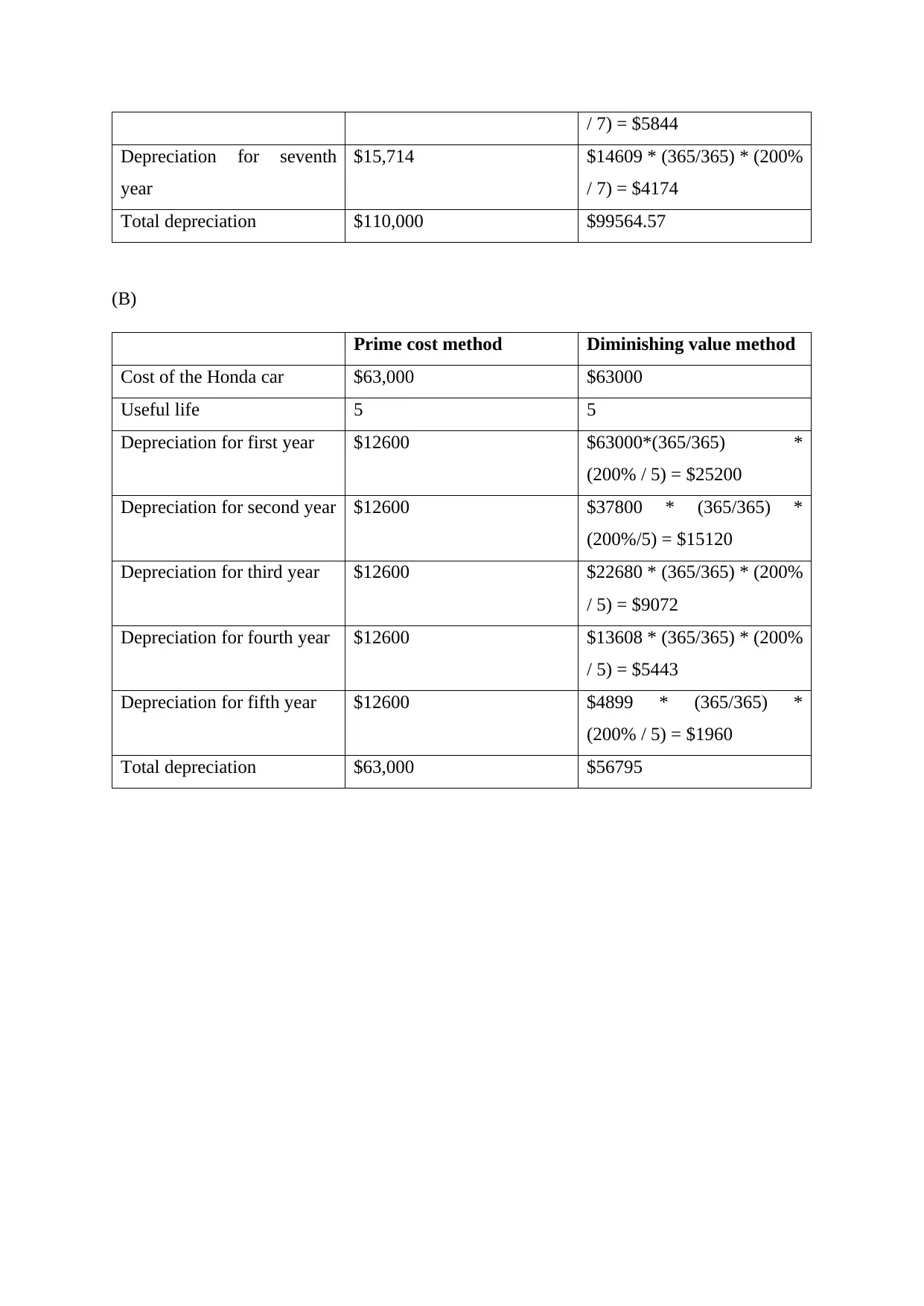
/ 7) = $5844
Depreciation for seventh
year
$15,714 $14609 * (365/365) * (200%
/ 7) = $4174
Total depreciation $110,000 $99564.57
(B)
Prime cost method Diminishing value method
Cost of the Honda car $63,000 $63000
Useful life 5 5
Depreciation for first year $12600 $63000*(365/365) *
(200% / 5) = $25200
Depreciation for second year $12600 $37800 * (365/365) *
(200%/5) = $15120
Depreciation for third year $12600 $22680 * (365/365) * (200%
/ 5) = $9072
Depreciation for fourth year $12600 $13608 * (365/365) * (200%
/ 5) = $5443
Depreciation for fifth year $12600 $4899 * (365/365) *
(200% / 5) = $1960
Total depreciation $63,000 $56795
Depreciation for seventh
year
$15,714 $14609 * (365/365) * (200%
/ 7) = $4174
Total depreciation $110,000 $99564.57
(B)
Prime cost method Diminishing value method
Cost of the Honda car $63,000 $63000
Useful life 5 5
Depreciation for first year $12600 $63000*(365/365) *
(200% / 5) = $25200
Depreciation for second year $12600 $37800 * (365/365) *
(200%/5) = $15120
Depreciation for third year $12600 $22680 * (365/365) * (200%
/ 5) = $9072
Depreciation for fourth year $12600 $13608 * (365/365) * (200%
/ 5) = $5443
Depreciation for fifth year $12600 $4899 * (365/365) *
(200% / 5) = $1960
Total depreciation $63,000 $56795
Paraphrase This Document
Need a fresh take? Get an instant paraphrase of this document with our AI Paraphraser
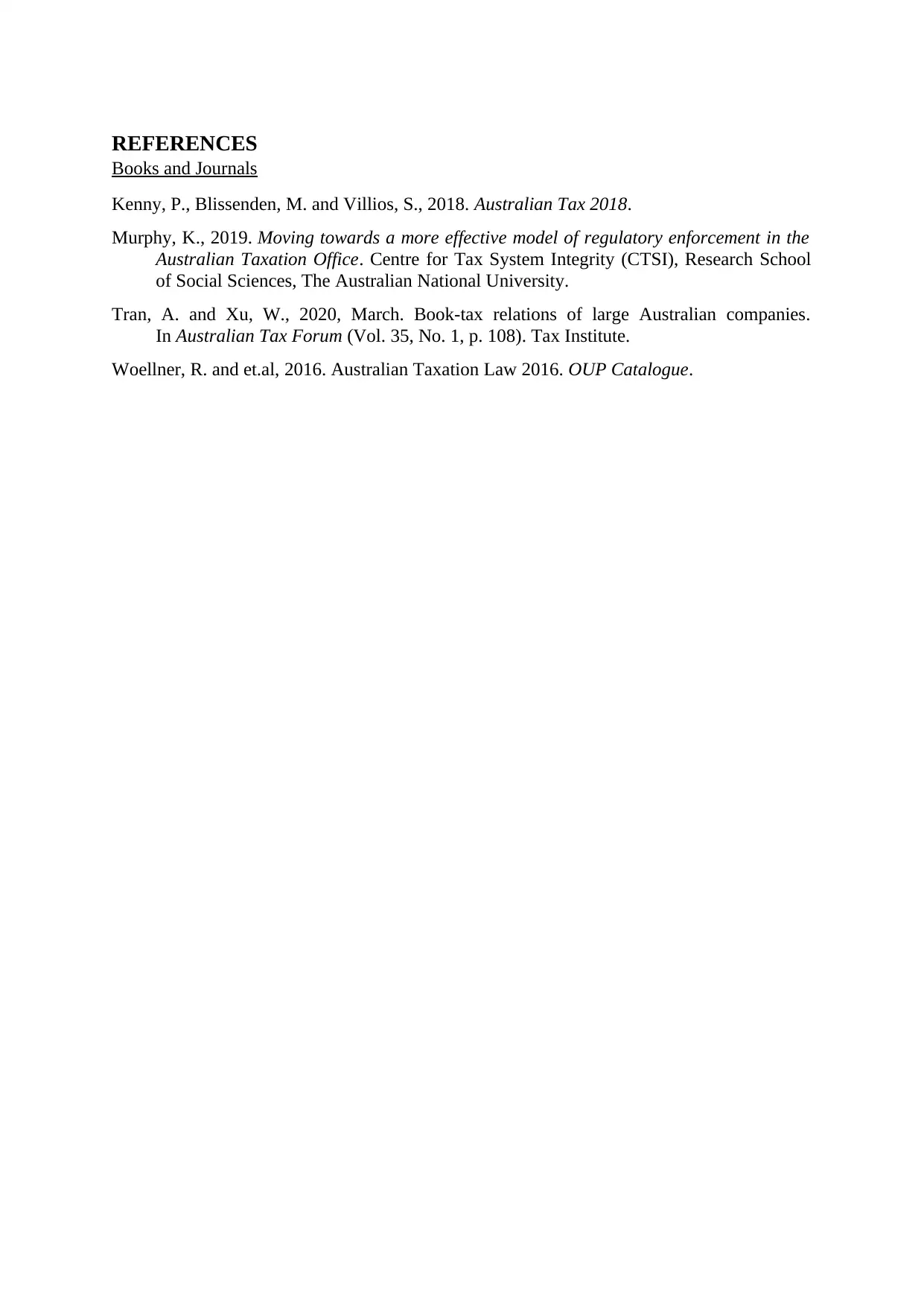
REFERENCES
Books and Journals
Kenny, P., Blissenden, M. and Villios, S., 2018. Australian Tax 2018.
Murphy, K., 2019. Moving towards a more effective model of regulatory enforcement in the
Australian Taxation Office. Centre for Tax System Integrity (CTSI), Research School
of Social Sciences, The Australian National University.
Tran, A. and Xu, W., 2020, March. Book-tax relations of large Australian companies.
In Australian Tax Forum (Vol. 35, No. 1, p. 108). Tax Institute.
Woellner, R. and et.al, 2016. Australian Taxation Law 2016. OUP Catalogue.
Books and Journals
Kenny, P., Blissenden, M. and Villios, S., 2018. Australian Tax 2018.
Murphy, K., 2019. Moving towards a more effective model of regulatory enforcement in the
Australian Taxation Office. Centre for Tax System Integrity (CTSI), Research School
of Social Sciences, The Australian National University.
Tran, A. and Xu, W., 2020, March. Book-tax relations of large Australian companies.
In Australian Tax Forum (Vol. 35, No. 1, p. 108). Tax Institute.
Woellner, R. and et.al, 2016. Australian Taxation Law 2016. OUP Catalogue.
1 out of 8
Related Documents
Your All-in-One AI-Powered Toolkit for Academic Success.
+13062052269
info@desklib.com
Available 24*7 on WhatsApp / Email
![[object Object]](/_next/static/media/star-bottom.7253800d.svg)
Unlock your academic potential
Copyright © 2020–2025 A2Z Services. All Rights Reserved. Developed and managed by ZUCOL.





